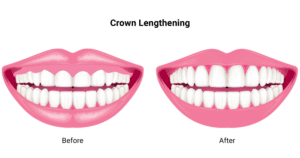ESTHETIC CROWN LENGTHENING
Periodontal plastic surgery is performed to improve the result of restorative and cosmetic dentistry including crowns, bridges and veneers, by enhancing appearance of the gum line.
If your teeth look short, or if you have a “gummy” smile, you can dramatically improve your smile in as little as an hour through a procedure called esthetic crown lengthening, also known as a “gum lift”. Crown lengthening involves reshaping excess gum and bone tissue to reveal more of your natural teeth. Depending on your preferences, the lengthening procedure can be used for a single tooth or a series of teeth.

What are the benefits of this procedure?
Esthetic crown lengthening is predominantly performed to expose more tooth structure for a better smile. It can also help prevent as well as treat periodontitis, “gum disease” if deep pockets exist.
FUNCTIONAL CROWN LENGTHENING
In certain circumstances, the periodontist may suggest a crown lengthening procedure as a functional component of related procedures: a decayed tooth, a tooth broken below the gum line, or to expose more tooth structure in order to complete a crown or bridge. Teeth that have undergone a crown lengthening can be properly restored because of the adjustments to the gum and bone level that expose more of the teeth.
What are the benefits of this procedure?
When teeth are decayed or broken close to or below the gum line, they can often only be saved through functional crown lengthening. The procedure exposes more of the tooth so your dentist can repair it with a crown or new restoration. Whether you have crown lengthening to improve function or esthetics, you will receive the benefits of both a beautiful smile and improved periodontal health.
ROOT RECESSION REPAIR
Gum recession is the result of movement of the gum line down the root of a tooth. Gum recession occurs as a result of bone loss around the tooth. This recession can be localized to one particular tooth or generalized in the mouth. Common symptoms can vary from no symptoms at all, to tooth sensitivity, inflammation of the tissue, root exposure and cavity development, to esthetic concerns. Today, root recession is easily repaired with simple tissue graft procedures.
What are the benefits of this procedure?
Gum tissue is the primary barrier to bacteria which have the potential to create infections inside the mouth. Without adequate attached gum tissue around your teeth, gum disease can develop leading to infections, gum and bone deterioration and even tooth loss. Tissue graft surgery builds the gum back to help you keep your teeth longer.
RIDGE MODIFICATION
Gum and bone recession can occur in areas of the mouth where teeth have been removed or have been missing for an extended period. This is referred to as “ridge resorption”. This resorption can be due to loss of gum tissue, underlying bone, or both and can be localized to one area or effect broader areas where teeth are missing. Ridge resorption often leads to food traps resulting in tooth decay as well as gum disease. It can also be a significant esthetic problem when it occurs in the “smile zone”, areas in the mouth visible when smiling. Ridge modification can be performed to improve the defects in the gum and bone, and repair the area for better esthetics and function.
What are the benefits of this procedure?
Ridge modification can be used to prepare an area for dental implants as well as a tooth supported bridge. Without modification of the ridge, dental implants to replace the missing teeth may not be possible. If a tooth retained bridge is made without ridge modification, food traps as well as esthetic problems can occur and compromise the longevity and service of the bridge.
FRENECTOMY
A frenectomy surgically repositions the frenum in the mouth. A frenum is a fold of tissue that passes from the movable lip or cheek to the gum. There are multiple frenums within the mouth, the most prominent being the ones in the front of the upper and lower teeth. When a frenum is positioned in such a way as to interfere with the normal alignment of teeth or results in pulling away of the gum from the tooth surface causing recession, they require repositioning with a simple, single surgical procedure.
What are the benefits of this procedure?
Frenectomies are simple procedures that when necessary help promote the long term health of the gums and teeth. They can also prevent orthodontic tooth relapse following orthodontic treatment.
MUCOGINGIVAL SURGERY
When recession of the gum occurs, the body loses a natural defense against both bacterial penetration and trauma. When gum recession is a problem, gum reconstruction using tissue grafts are often necessary.
When there is only minor recession, some healthy gum often remains and protects the tooth. Often no treatment other than modifying home care practices is necessary. However, when recession is advanced or reaches the mucosa (the movable gum tissue attached to the lips and cheeks), the first line of defense against bacterial penetration is lost.
Tissue grafts are performed to solve these problems. A thin piece of tissue is taken from the roof of the mouth, or gently moved over from adjacent areas, to provide a stable band of attached gum around the tooth. The gingival graft may be placed in such a way as to either cover the jaw only or cover the exposed portion of the root, as well. In contrast to root recession repair the primary objective of this procedure is to gain firm gum tissue around the teeth for better protection against gum disease. A free gingival graft in comparison to a connective tissue graft is often performed when root coverage is not possible or predictable.
